Tharmalingam Ratnarajah
Variational Bayesian Channel Estimation and Data Detection for Cell-Free Massive MIMO with Low-Resolution Quantized Fronthaul Links
Jun 23, 2025Abstract:We study the joint channel estimation and data detection (JED) problem in a cell-free massive multiple-input multiple-output (CF-mMIMO) network, where access points (APs) communicate with a central processing unit (CPU) over fronthaul links. However, the bandwidth of these links is limited, and thus, presents challenges to the applicability of CF-mMIMO, especially with an ever-increasing number of users. To address this, we propose a method based on variational Bayesian (VB) inference for performing the JED process, where the APs forward low-resolution quantized versions of the signals to the CPU. We consider two approaches: \emph{quantization-and-estimation} (Q-E) and \emph{estimation-and-quantization} (E-Q). In the Q-E approach, each AP uses a low-bit quantizer to quantize the signal before forwarding it to the CPU, while in the E-Q approach, each AP first performs local channel estimation and then sends a low-bit quantized version of the estimated channel to the CPU. We evaluate the performance of our VB-based approach under perfect fronthaul link (PFL) with unquantized received signals, Q-E, and E-Q in terms of symbol error rate (SER), normalized mean square error (NMSE) of the channel estimation, computational complexity, and fronthaul signaling overhead. We also compare these results with those of the linear minimum mean squared error (LMMSE) method under the PFL scenario. Our numerical results show that both the VB(Q-E) and VB(E-Q) approaches achieve superior performance compared to LMMSE(PFL), benefiting from the nonlinear modeling inherent in VB. Furthermore, the VB(Q-E) method outperforms VB(E-Q) due to errors in the local channel estimation process at the APs within the VB(E-Q) approach.
Federated Dropout: Convergence Analysis and Resource Allocation
Dec 31, 2024



Abstract:Federated Dropout is an efficient technique to overcome both communication and computation bottlenecks for deploying federated learning at the network edge. In each training round, an edge device only needs to update and transmit a sub-model, which is generated by the typical method of dropout in deep learning, and thus effectively reduces the per-round latency. \textcolor{blue}{However, the theoretical convergence analysis for Federated Dropout is still lacking in the literature, particularly regarding the quantitative influence of dropout rate on convergence}. To address this issue, by using the Taylor expansion method, we mathematically show that the gradient variance increases with a scaling factor of $\gamma/(1-\gamma)$, with $\gamma \in [0, \theta)$ denoting the dropout rate and $\theta$ being the maximum dropout rate ensuring the loss function reduction. Based on the above approximation, we provide the convergence analysis for Federated Dropout. Specifically, it is shown that a larger dropout rate of each device leads to a slower convergence rate. This provides a theoretical foundation for reducing the convergence latency by making a tradeoff between the per-round latency and the overall rounds till convergence. Moreover, a low-complexity algorithm is proposed to jointly optimize the dropout rate and the bandwidth allocation for minimizing the loss function in all rounds under a given per-round latency and limited network resources. Finally, numerical results are provided to verify the effectiveness of the proposed algorithm.
OFDM-Based Active STAR-RIS-Aided Integrated Sensing and Communication Systems
Jun 04, 2024Abstract:Simultaneously transmitting and reflecting reconfigurable intelligent surface (STAR-RIS), which consists of numerous passive elements, has recently emerged in wireless communication systems as a promising technology providing 360$^\circ$ coverage and better performance. In our research, we introduce an active STAR-RIS (ASTARS)-aided integrated sensing and communications (ISAC) system designed to optimize the radar signal-to-noise ratio (SNR), enhancing detection and signal transmission efficiency. The introduction of an ISAC system aims to improve both communication efficiency and sensing capabilities. Also, we employ orthogonal frequency division multiplexing (OFDM) to address the frequency-selective fading problem. Furthermore, we evaluate the radar sensing capabilities by examining the range and velocity, and assess the performance through the mean-squared error (MSE) of their estimations. Our simulation results demonstrate that ASTARS outperforms STAR-RIS in our system configurations, and that the proposed optimization approach further enhances the system performance. Additionally, we confirm that an increase in the subcarrier spacing can reduce the transmission bit error rate (BER) under high-velocity conditions.
Joint Power Allocation and Beamforming for In-band Full-duplex Multi-cell Multi-user Networks
Mar 16, 2024



Abstract:This paper investigates a robust joint power allocation and beamforming scheme for in-band full-duplex multi-cell multi-user (IBFD-MCMU) networks. A mean-squared error (MSE) minimization problem is formulated with constraints on the power budgets and residual self-interference (RSI) power. The problem is not convex, so we decompose it into two sub-problems: interference management beamforming and power allocation, and give closed-form solutions to the sub-problems. Then we propose an iterative algorithm to yield an overall solution. The computational complexity and convergence behavior of the algorithm are analyzed. Our method can enhance the analog self-interference cancellation (ASIC) depth provided by the precoder with less effect on the downlink communication than the existing null-space projection method, inspiring a low-cost but efficient IBFD transceiver design. It can achieve 42.9% of IBFD gain in terms of spectral efficiency with only antenna isolation, while this value increases to 60.9% with further digital self-interference cancellation (DSIC). Numerical results illustrate that our algorithm is robust to hardware impairments and channel uncertainty. With sufficient ASIC depth, our method reduces the computation time by at least 20% than the existing scheme due to its faster convergence speed at the cost of < 12.5% sum rate loss. The benefit is much more significant with single-antenna users that our algorithm saves at least 40% of the computation time at the cost of < 10% sum rate reduction.
On the Secrecy Rate of In-Band Full-duplex Two-way Wiretap Channel
Mar 11, 2024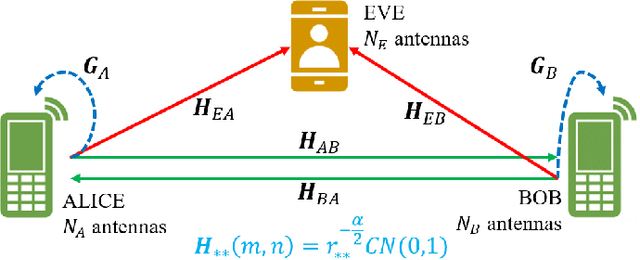
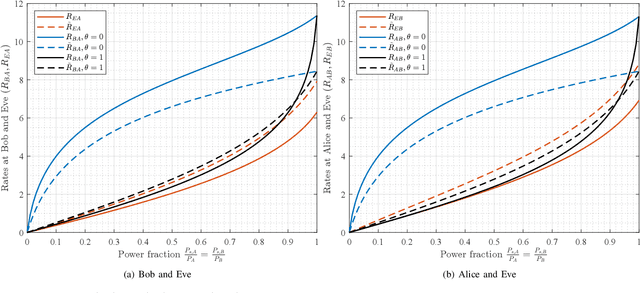
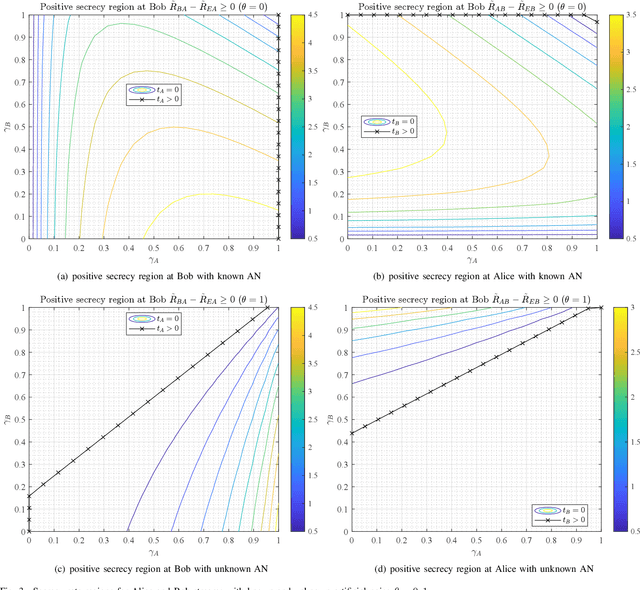

Abstract:In this paper, we consider a two-way wiretap Multi-Input Multi-Output Multi-antenna Eve (MIMOME) channel, where both nodes (Alice and Bob) transmit and receive in an in-band full-duplex (IBFD) manner. For this system with keyless security, we provide a novel artificial noise (AN) based signal design, where the AN is injected in both signal and null spaces. We present an ergodic secrecy rate approximation to derive the power allocation algorithm. We consider scenarios where AN is known and unknown to legitimate users and include imperfect channel information effects. To maximize secrecy rates subject to the transmit power constraint, a two-step power allocation solution is proposed, where the first step is known at Eve, and the second step helps to improve the secrecy further. We also consider scenarios where partial information is known by Eve and the effects of non-ideal self-interference cancellation. The usefulness and limitations of the resulting power allocation solution are analyzed and verified via simulations. Results show that secrecy rates are less when AN is unknown to receivers or Eve has more information about legitimate users. Since the ergodic approximation only considers Eves distance, the resulting power allocation provides secrecy rates close to the actual ones.
Two-Timescale Design for Active STAR-RIS Aided Massive MIMO Systems
Feb 15, 2024Abstract:Simultaneously transmitting and reflecting \textcolor{black}{reconfigurable intelligent surface} (STAR-RIS) is a promising implementation of RIS-assisted systems that enables full-space coverage. However, STAR-RIS as well as conventional RIS suffer from the double-fading effect. Thus, in this paper, we propose the marriage of active RIS and STAR-RIS, denoted as ASTARS for massive multiple-input multiple-output (mMIMO) systems, and we focus on the energy splitting (ES) and mode switching (MS) protocols. Compared to prior literature, we consider the impact of correlated fading, and we rely our analysis on the two timescale protocol, being dependent on statistical channel state information (CSI). On this ground, we propose a channel estimation method for ASTARS with reduced overhead that accounts for its architecture. Next, we derive a \textcolor{black}{closed-form expression} for the achievable sum-rate for both types of users in the transmission and reflection regions in a unified approach with significant practical advantages such as reduced complexity and overhead, which result in a lower number of required iterations for convergence compared to an alternating optimization (AO) approach. Notably, we maximize simultaneously the amplitudes, the phase shifts, and the active amplifying coefficients of the ASTARS by applying the projected gradient ascent method (PGAM). Remarkably, the proposed optimization can be executed at every several coherence intervals that reduces the processing burden considerably. Simulations corroborate the analytical results, provide insight into the effects of fundamental variables on the sum achievable SE, and present the superiority of 16 ASTARS compared to passive STAR-RIS for a practical number of surface elements.
Computation and Communication Efficient Federated Learning over Wireless Networks
Sep 21, 2023



Abstract:Federated learning (FL) enables distributed learning across edge devices while protecting data privacy. However, the learning accuracy decreases due to the heterogeneity of devices' data, and the computation and communication latency increase when updating large-scale learning models on devices with limited computational capability and wireless resources. We consider a novel FL framework with partial model pruning and personalization to overcome these challenges. This framework splits the learning model into a global part with model pruning shared with all devices to learn data representations and a personalized part to be fine-tuned for a specific device, which adapts the model size during FL to reduce both computation and communication latency and increases the learning accuracy for the device with non-independent and identically distributed (non-IID) data. Then, the computation and communication latency and the convergence analysis of the proposed FL framework are mathematically analyzed. To maximize the convergence rate and guarantee learning accuracy, Karush Kuhn Tucker (KKT) conditions are deployed to jointly optimize the pruning ratio and bandwidth allocation. Finally, experimental results demonstrate that the proposed FL framework achieves a remarkable reduction of approximately 50 percents computation and communication latency compared with the scheme only with model personalization.
Performance Analysis of In-Band-Full-Duplex Multi-Cell Wideband IAB Networks
May 08, 2023



Abstract:This paper analyzes the performance of the 3rd Generation Partnership Project (3GPP)-inspired multi-cell wideband single-hop backhaul millimeter-wave-in-band-full-duplex (IBFD)-integrated access and backhaul (IAB) networks by using stochastic geometry. We model the wired-connected Next Generation NodeBs (gNBs) as the Mat\'ern hard-core point process (MHCPP) to meet the real-world deployment requirement and reduce the cost caused by wired connection in the network. We first derive association probabilities that reflect how likely the typical user-equipment is served by a gNB or an IAB-node based on the maximum long-term averaged biased-received-desired-signal power criteria. Further, by leveraging the composite Gamma-Lognormal distribution, we derive the closed-form signal to interference plus noise ratio coverage, capacity with outage, and ergodic capacity of the network. In order to avoid underestimating the noise, we consider the sidelobe gain on inter-cell interference links and the analog to digital converter quantization noise. Compared with the half-duplex transmission, numerical results show an enhanced capacity with outage and ergodic capacity provided by IBFD under successful self-interference cancellation. We also study how the power bias and density ratio of the IAB-node to gNB, and the hard-core distance can affect system performances.
A Novel Frame Structure for Cloud-Based Audio-Visual Speech Enhancement in Multimodal Hearing-aids
Oct 24, 2022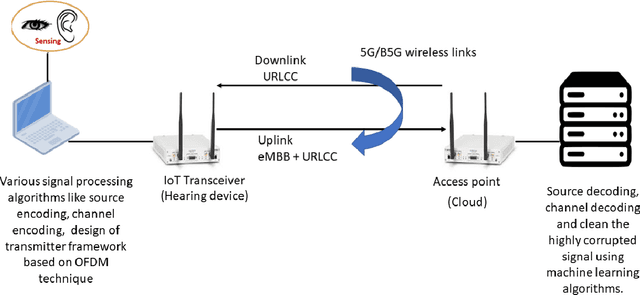
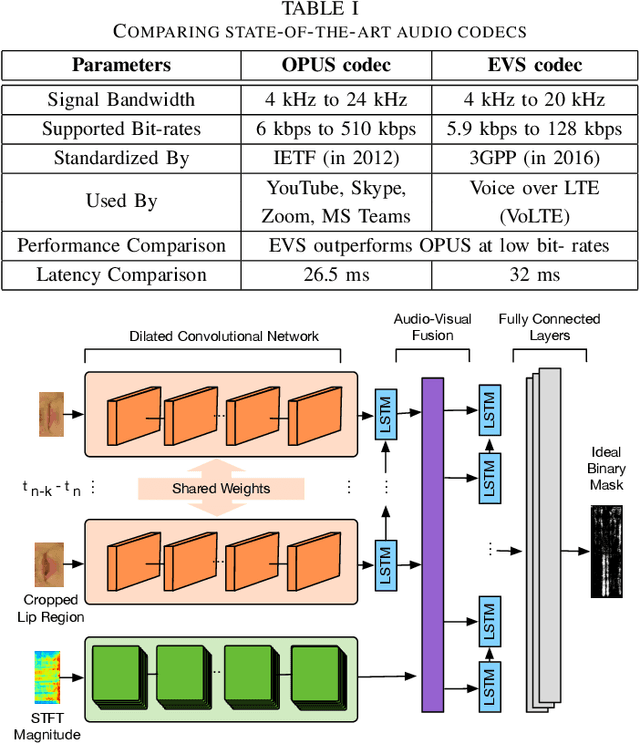
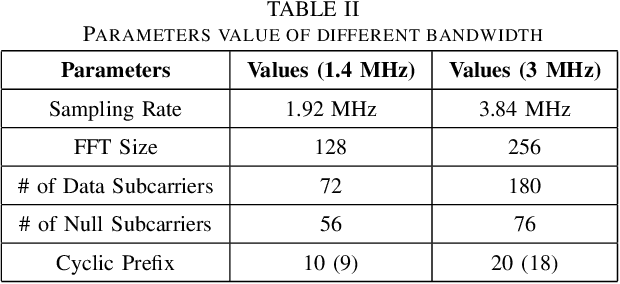
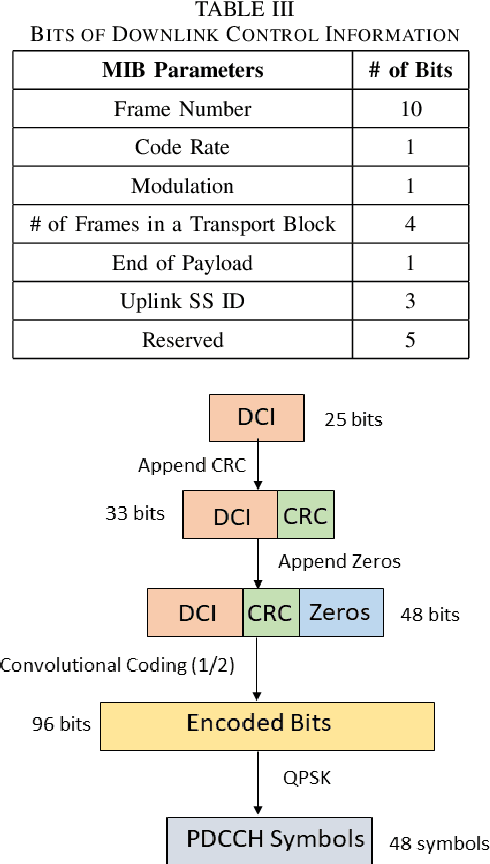
Abstract:In this paper, we design a first of its kind transceiver (PHY layer) prototype for cloud-based audio-visual (AV) speech enhancement (SE) complying with high data rate and low latency requirements of future multimodal hearing assistive technology. The innovative design needs to meet multiple challenging constraints including up/down link communications, delay of transmission and signal processing, and real-time AV SE models processing. The transceiver includes device detection, frame detection, frequency offset estimation, and channel estimation capabilities. We develop both uplink (hearing aid to the cloud) and downlink (cloud to hearing aid) frame structures based on the data rate and latency requirements. Due to the varying nature of uplink information (audio and lip-reading), the uplink channel supports multiple data rate frame structure, while the downlink channel has a fixed data rate frame structure. In addition, we evaluate the latency of different PHY layer blocks of the transceiver for developed frame structures using LabVIEW NXG. This can be used with software defined radio (such as Universal Software Radio Peripheral) for real-time demonstration scenarios.
Reinforcement Learning based Per-antenna Discrete Power Control for Massive MIMO Systems
Jan 28, 2021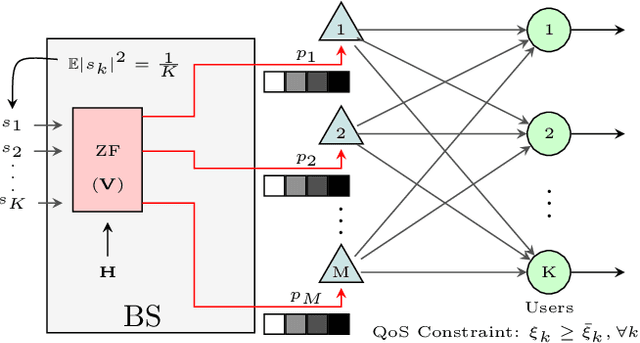
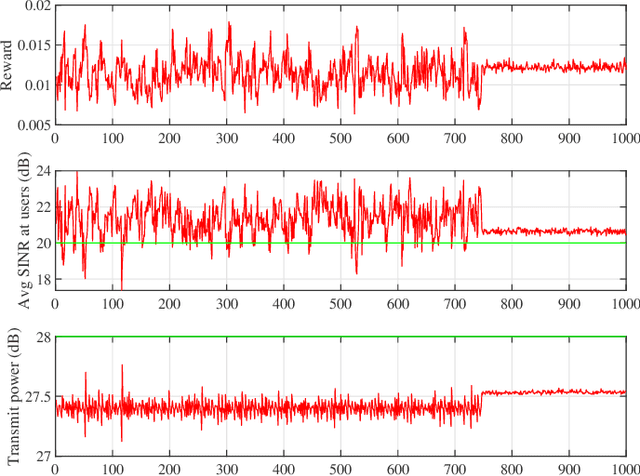
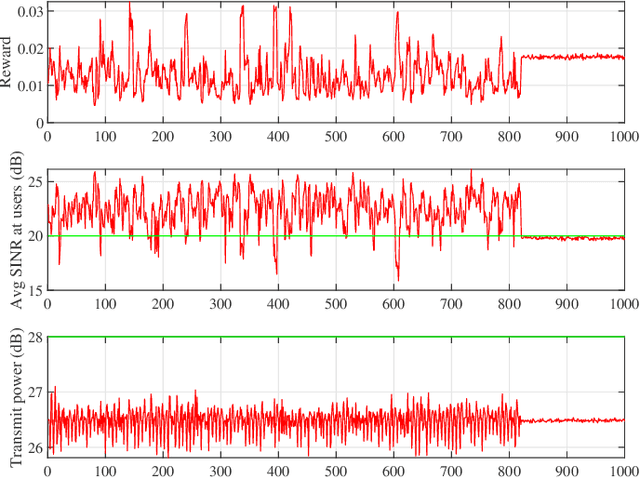
Abstract:Power consumption is one of the major issues in massive MIMO (multiple input multiple output) systems, causing increased long-term operational cost and overheating issues. In this paper, we consider per-antenna power allocation with a given finite set of power levels towards maximizing the long-term energy efficiency of the multi-user systems, while satisfying the QoS (quality of service) constraints at the end users in terms of required SINRs (signal-to-interference-plus-noise ratio), which depends on channel information. Assuming channel states to vary as a Markov process, the constraint problem is modeled as an unconstraint problem, followed by the power allocation based on Q-learning algorithm. Simulation results are presented to demonstrate the successful minimization of power consumption while achieving the SINR threshold at users.
 Add to Chrome
Add to Chrome Add to Firefox
Add to Firefox Add to Edge
Add to Edge